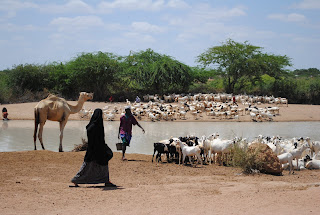We arrived in Kenya on the 1st and after a day in Nairobi we traveled by car to Garissa.
Garissa is a town in the Northeastern province where our friend Christine is just completing her internship. It is dry, dusty and unbearably hot. The streets are lined with garbage, much of it in smoldering burn piles, so that the smell of the black exhaust billowing from every passing matatu(mini-van), taxi and bus is almost indistinguishable from the smell of burning plastic. Goats, cows, camels, and flocks of storks rummage through whatever trash is't burning; chewing on (and often swallowing whole) unidentifiable pieces of rubbish.
The people here are predominately Somali Kenyans -- born in Kenya in an area that was historically part of Somalia- but we are told that they are ethnically, linguistically and culturally indistinct from Somali-Somalis. Mazungus (white people) are very rare here, and almost invariably associated with one of the many NGOs, passing through on their way to the refugee camps north of here. There are only a very few women not wearing burkas.
After two days in Garissa we moved on to Dadaab where the three largest refugee camps in Kenya are located. Together they make up a population of over 250,000 refugees - predominantly Somali, but also Congalese, Sudanese, Ethiopian, etc.
Christine had helped us get in touch with the African NGO ADEO (African Disaster and Emergency Organization), who offered to host our visit to the camps. We stayed in an enormous UN compound, fenced with barbed wire and divided into multiple smaller compounds for the various NGOs working in the camps. The buildings are predominantly made with cement block and provide basic accommodationfor the NGO workers. In collaboration with the Kenyan government, most services are overseen and funded by the UNHCR (United Nations High Commission on Refugees).
We stayed in the compound of a German NGO which was in charge of one of the hospitals we were visiting, and we ate our daily meals with their employees. The first meal of rice, ugali (a corn based past a bit like a dry tamale without any filling), and goat stew was quite appetizing.... but after eating the same thing for lunch and dinner for 10 days we were all dying for something different and appreciating the ability to get meat in the US without bone shards in every bite.
ADEO coordinated numerous customary (and mandatory) meetings with all the directors, ministers and officers of the various governmental and NGO refugee organizations and after a few days we had all the permission and blessings needed to actually enter the camps.
The camps are enormous and to my surprise didn't have any distinct borders. Although there movement is severely limited within the rest of Kenya, the refugees were able to move freely between the camps, into the town of Dadaab and into the surrounding bush. The buildings here are almost uniformly huts built from sticks and differ only in size and roofing material. Many have stick roofs covered with plastic bags and old clothing to cover the gaps as best as possible, a few are plastered with mud, some have UNHCR issued tarps and even fewer have corrugated tin roofs. Others have doors and roofs made from used tin cans, beaten flat and saudered together, with USA stamped in blue on each of the cans, complements of US food aid.
The refugees are not allowed to work in Kenya but everyone tells us that there is a huge amount of money traveling through here -- piracy and drug and arms smuggling are apparently big business here - and as a result the camps are like little cities - with markets that sell anything and everything you could ever want.




































